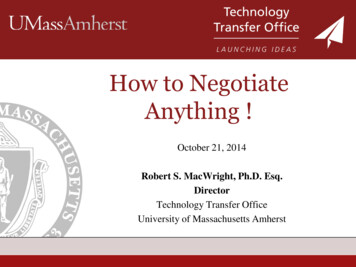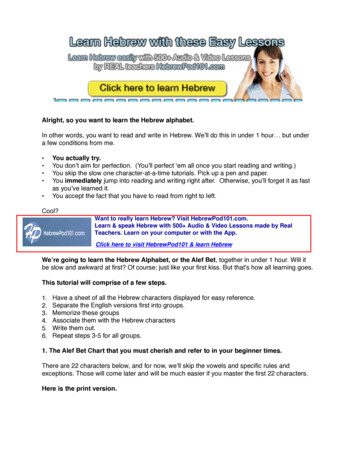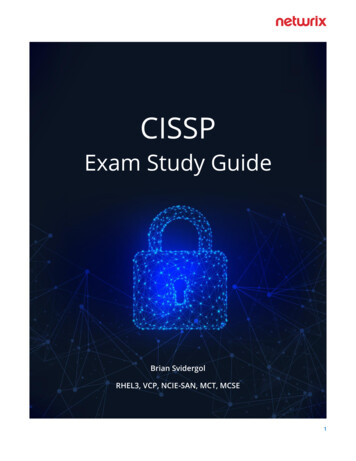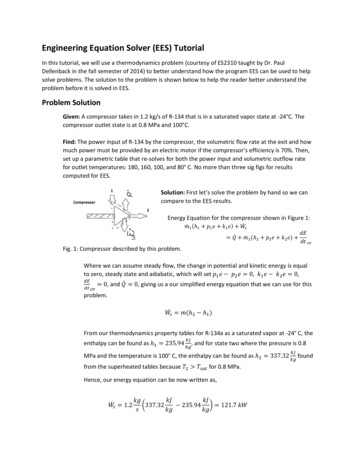
Transcription
If You Want to Study in the United States: Undergraduate StudyBureau of Educational and Cultural AffairsU.S. Department of StateEducationUSA.state.gov18-21549 IYWTS Bk1 REV2018 cov CX6.indd 1If You Wantto Study in theUNITED STATES1UNDERGRADUATESTUDY8/9/21 7:40 AM
Editor: Erica T. BurmanCover Art: Designed by FreepikNOTE: Inclusion of a website or publication in this booklet does not indicate recommendation or approval by theU.S. Department of State; it is for information purposes only. Listings of websites and publications are aselection only and should not be considered a complete list of those available.18-21549 IYWTS Bk1 REV2018 cov CX6.indd 28/9/21 7:40 AM
If You Wantto Study in theUNITED STATES1UNDERGRADUATESTUDY18-21549 IYWTS Bk1 REV2018 ins CX12.indd 17/16/21 6:57 AM
18-21549 IYWTS Bk1 REV2018 ins CX12.indd 27/16/21 6:57 AM
PrefaceUndergraduate Study is one of a series of four introductory booklets produced by the U.S. Department of State toprovide objective and practical advice to prospective international students and scholars on studying in the UnitedStates.The four booklets cover the following areas:Undergraduate StudyHow to choose and apply to U.S. bachelor’s and associatedegree programs, plus information on technical and vocational educational opportunities in the United States.Graduate and Professional Study and ResearchHow to research and apply to U.S. master’s, doctoral degree,and postdoctoral programs, plus information on certification and licensing procedures for professionals who wish tofurther their education or practice in the United States.Short-Term Study, English Language Programs,Distance Education, and AccreditationInformation on opportunities to study in the United Statesfor up to one year, plus an overview of studying toward adegree, diploma, or certificate from outside the UnitedStates through distance education programs. The bookletalso includes detailed information on accreditation of U.S.higher education institutions.Getting Ready to Go: Practical Information forLiving and Studying in the United StatesHelp with planning your move to the United States afteryou have been accepted to a U.S. university or college. Thisbooklet provides advice on applying for a visa, moving tothe United States, and what to expect when you arrive oncampus.If You Want to Study in the United States: Undergraduate Study18-21549 IYWTS Bk1 REV2018 ins CX12.indd 337/16/21 6:57 AM
The United Sta te4If You Want to Study in the United States: Undergraduate Study18-21549 IYWTS Bk1 REV2018 ins CX12.indd 47/16/21 7:37 AM
ta tes of AmericaIf You Want to Study in the United States: Undergraduate Study18-21549 IYWTS Bk1 REV2018 ins CX12.indd 557/16/21 7:37 AM
Contents6IntroductionWhy Study in the United States?EducationUSA Advising Centers10Chapter 1U.S. Undergraduate EducationColleges, Universities, and Institutes:The DistinctionBachelor’s and Associate DegreesThe Liberal Arts PhilosophyProfessional EducationTypes of InstitutionsState UniversitiesPrivate UniversitiesCommunity CollegesTechnical and Vocational CollegesDistance EducationNon-Degree Study at a U.S. CollegeResources13Chapter 2The U.S. Bachelor’s DegreeAcademic CalendarThe Credit SystemDegree CoursesGradesWhat Is a GPA?Resource18Chapter 3Community CollegesPrograms of StudyAcademic ProgramsWorkforce Education ProgramsLifelong/Continuing EducationProgramsAccreditationArticulationStudents with DisabilitiesAdmission RequirementsCosts, Work Opportunities,and ScholarshipsFlexible English ProficiencyRequirementsHousing OptionsResources22Chapter 4Choosing the Best Colleges for YouTools to Help You Choose27If You Want to Study in the United States: Undergraduate Study18-21549 IYWTS Bk1 REV2018 ins CX12.indd 67/16/21 6:57 AM
ContentsEducationUSA Advising CentersCollege Websites and E-MailCollege Searches on the WebSocial Media ToolsU.S. College/University Fairs and VisitsCampus VisitsEducational Consultants andRecruiting AgentsThings to ConsiderAcademic ConsiderationsAccreditation and Recognition ofDegreesMajorAcademic EmphasisSelectivityDegree Program StructureAdvanced StandingStudent-to-Teacher RatioLifestyle ConsiderationsCostHousingLocationSizeCollege EnvironmentSocial LifeFraternities and SororitiesInternational StudentsAffiliationsExtracurricular ActivitiesOther ConsiderationsBeyond the Ivy LeagueRankingsStudent ServicesInternship/Overseas Study ProgramsStudy Abroad Office/InternationalCenter on CampusesStudents with DisabilitiesResourcesChapter 5Entrance RequirementsSecondary School Diplomas/Examination ResultsStandardized Admissions TestsThe ACTThe SATIf You Want to Study in the United States: Undergraduate Study18-21549 IYWTS Bk1 REV2018 ins CX12.indd 74077/16/21 6:57 AM
ContentsEnglish Language AbilityResources8Chapter 6Financing Your EducationPlanning AheadCalculating Your ExpensesTuition and FeesLiving CostsFinancing Your EducationAssessing Personal FundsIdentifying Sources of FinancialAssistanceReducing Educational CostsResources44Chapter 7Advice and Information forInternational Student Athletes52Major Collegiate-Level AthleticAssociationsSports Sponsored by AthleticAssociationsAcademic Eligibility Requirements andProcess for Athletic AssociationsAmateurism Eligibility Requirementsfor Athletic AssociationsEligibility Certification by AthleticAssociationsSports Resumes and How to Findand Contact CoachesAthletic/Sports ScholarshipsOther Options for AthletesResourcesChapter 8Preparing a SuccessfulApplicationRequesting Application MaterialsRegistering for Admissions TestsCompleting and ReturningApplication MaterialsApplication FormApplication FeeAcademic CredentialsTest Score ReportingPersonal StatementRecommendationsFinancial Statement57If You Want to Study in the United States: Undergraduate Study18-21549 IYWTS Bk1 REV2018 ins CX12.indd 87/16/21 6:57 AM
ContentsDeadlines and SubmissionMid-Year AdmissionsInterviewsCommon Application FormAcceptanceResourcesChapter 9The Application Process:A Timetable and ChecklistChapter 10Transferring to a U.S. UniversityCredit TransferTransferring between U.S. InstitutionsTransferring from Outside the U.S.Education SystemThe Transfer Application ProcessResourcesChapter 11Student and Exchange VisitorInformation System (SEVIS) andStudent VisasStudent and Exchange VisitorInformation System (SEVIS)Visa TypesProcedures for Your CountryApplying for a Student Visa:A Step-by-Step GuideVisa RefusalsResources677077Chapter 12U.S. University LifeArrival in the United StatesOrientationInternational Student Advisers (ISAs)Academic Adviser (AA)University HousingMoney and BankingHealth InsuranceExtracurricular ActivitiesResources82AppendicesGlossary of Terms86Index95If You Want to Study in the United States: Undergraduate Study18-21549 IYWTS Bk1 REV2018 ins CX12.indd 997/16/21 6:57 AM
IntroductionThousands of colleges and universities offer undergraduate degree programs in the United States. This vast choicemeans there are programs available to meet everyone’sneeds, but how can you find the best program for you? Thisbooklet aims to give you not only the knowledge you needto make the right choices, but also the confidence to prepare successful applications.Why Study in the United States?Here are just a few of the reasons why more than a millioninternational students are furthering their education in theUnited States:Quality: U.S. colleges and universities are known worldwide for the quality of their facilities, resources, and faculty.Accreditation systems ensure that institutions continue tomaintain these standards. Chapters 1 and 2 explain the U.S.system of undergraduate education. Chapter 4 highlightsthe type of accreditation you should look for when applyingto U.S. colleges.Choice: The U.S. education system is unrivaled in the choiceit offers in types of institutions, academic and social environments, degree programs, and subjects in which to specialize. Chapters 4 and 5 explain the entry requirements andguide you through the process of choosing the right collegeor university for you.Diversity: You can find a mix of people from all differentbackgrounds and all corners of the globe on U.S. campuses;in 2018/19, more than a million international students studied in the United States.Value: As an investment in your future, a U.S. degree offers excellent value for the money. A wide range of tuitionfees and living costs, plus some financial help from colleges,make study in the United States affordable. Chapters 6 and7 offer information and advice on the costs and financing ofyour U.S. education.10If You Want to Study in the United States: Undergraduate Study18-21549 IYWTS Bk1 REV2018 ins CX12.indd 107/16/21 6:57 AM
IntroductionFlexibility: Students at U.S. universities and colleges maychoose from many courses within their college or universityand have the option to move from one institution to another.Completing the first two years of a degree at one institution,usually a community college, and then moving to another, isvery common. Chapters 3 and 10 describe community colleges and explain the transfer system.This booklet will also help you prepare successful collegeapplications (Chapters 8 and 9) and apply for a visa (Chapter 11). Chapter 12 explains what to expect when you arrivein the United States. A glossary at the end of the book explains some of the words and phrases you will come acrossfrequently when applying to study in the United States.EducationUSA Advising Centers“The advising center was a great resource in the process of choosing my school. My counselor helped meevery step of the way, from choosing the right institution and taking the TOEFL to applying for financial aidand understanding culture shock.”— Political science and international studies studentfrom the Dominican RepublicChoosing the best schools for you and preparing successfulapplications will require commitment and careful planning onyour part, but in almost every country there are specializedadvisers who understand your needs and can help you. Information and advice on study in the United States are available to you from a network of more than 400 EducationUSAadvising centers worldwide. Directories, guides, college catalogs, and admissions test information are available at thecenters. You can also meet trained educational advisers whowant to help you and your family with the process of choosing and applying to U.S. colleges and universities. Somecenters also run events like college fairs or seminars. Introductory information in the form of video or group presentations, website access, and independent resource libraries isavailable free of charge, but payment may be required atsome centers for additional services.If You Want to Study in the United States: Undergraduate Study18-21549 IYWTS Bk1 REV2018 ins CX12.indd 11117/16/21 6:57 AM
IntroductionAll EducationUSA advising centers are supported by theU.S. Department of State, with the goal of providing accurate, comprehensive, and current information about opportunities to study at accredited higher education institutionsin the United States; however, the names of the centers andthe organizations that run them vary from country to country. To locate the center nearest you, contact your closestU.S. embassy or consulate, or consult the list available onthe EducationUSA website er).Good luck with your applications!12If You Want to Study in the United States: Undergraduate Study18-21549 IYWTS Bk1 REV2018 ins CX12.indd 127/16/21 6:57 AM
Chapter 1U.S. Undergraduate EducationEducation in the United Stateswill almost certainly be differentfrom the system offered in yourcountry. This chapter gives youan introduction to the degreesavailable in the United States,the different types of institutions,and some key terms and ideasyou will come across if you wantto study at a U.S. university orcollege.Colleges, Universities, andInstitutes: The DistinctionDegree-granting institutions inthe United States can be called byany of these terms, and collegesand institutes are in no way inferior to universities. As a generalrule, colleges tend to be smallerand usually offer only undergrad-uate degrees, while universitiesalso offer graduate degrees. Thewords “school,” “college,” and“university” will be used interchangeably throughout this booklet. An institute usually specializesin degree programs in a group ofclosely related subject areas, soyou will likely come across degreeprograms offered at institutes oftechnology, institutes of fashion,and institutes of art and design,among others.Within each college or university you will find schools, such asthe school of arts and sciencesor the school of business. Eachschool is responsible for the degree programs offered by thecollege or university in that areaof study.If You Want to Study in the United States: Undergraduate Study18-21549 IYWTS Bk1 REV2018 ins CX12.indd 13137/16/21 6:57 AM
Chapter 1 U.S. Undergraduate EducationBachelor’s and AssociateDegreesA bachelor’s degree typically takesfour years to complete. An associate degree usually takes twoyears to complete. Associate degree programs may be “terminal”programs, which lead to specificcareers upon graduation, or “transfer” programs, which correspondto the first two years of a bachelor’s degree. Under the latter option, students may transfer into thethird year of a four-year bachelor’sdegree program. Associate degreeprograms are offered at two-yearcolleges known as junior or community colleges (see below). Somecommunity colleges may also offer a limited number of four-yearbachelor’s degree programs. Fouryear colleges and universities offerbachelor’s degree programs, witha small number also offering associate degree programs.The Liberal Arts PhilosophyU.S. undergraduate education isbased on the concept of “liberalarts,” with the goal of providing awell-rounded academic educationthat develops students’ verbal,written, and reasoning skills. Students at a liberal arts college, orat a university with a strong liberalarts program, begin their degreestudy by taking classes in a widevariety of courses in the arts, hu14manities, languages, and the social and physical sciences. Theythen choose a subject in whichto specialize (called a major) andtake about 25 to 50 percent oftheir classes in their major. Eventhose who do not follow a liberalarts program and instead plan tomajor in a specialized subject likeengineering are usually requiredto take about 25 percent of theirclasses in humanities and socialsciences to complement theirstudies. Similarly, a student whowants to complete a major in history may be required to take someclasses in mathematics and thesciences.Professional EducationProfessional (career-oriented) education is included within the U.S.university system. Large universities tend to be comprised of acollege of arts and sciences andseveral professional schools focusing on fields such as business, agriculture, medicine, law, journalism,public policy, technology, or international affairs. More informationon professional education can befound in Booklet Two of this series,Graduate and Professional Studyand Research.Types of InstitutionsThis section will address the various types of degree-granting in-If You Want to Study in the United States: Undergraduate Study18-21549 IYWTS Bk1 REV2018 ins CX12.indd 147/16/21 6:57 AM
Chapter 1 U.S. Undergraduate Educationstitutions in the United States tohelp you determine which onemay be the right fit for you.State UniversitiesState universities are founded andsubsidized by U.S. state governments (for example, California,Michigan, or Texas) to providelow-cost education to residentsof those states. They may also becalled public universities to distinguish them from private institutions. Some include the words“state university” in their title orinclude a regional element (forexample, East Carolina University or Western Connecticut StateUniversity). State universities tendto be very large, with enrollmentsof 20,000 or more students, andgenerally admit a wider range ofstudents than private universities. State university tuition costsare generally lower than those ofprivate universities. Also, in-stateresidents (those who live and paytaxes in that particular state) paymuch lower tuition than out-ofstate residents. International students, as well as those from otherstates, are usually considered outof-state residents and therefore donot benefit from reduced tuitionat state institutions. In addition,international students may haveto fulfill higher admission requirements than in-state residents. Asmall number of institutions of-fer in-state tuition to internationalstudents through sister-city/country arrangements or because theyhave special agreements with institutions in other countries. Checkwith your EducationUSA adviser tosee if your country, or an institutionin your country, has such agreements with partners in the UnitedStates.Private UniversitiesPrivate institutions are funded bya combination of endowments, tuition fees, research grants, and giftsfrom their alumni. Tuition fees tendto be higher at private universitiesthan at state universities, but thereis no distinction made betweenstate and non-state residents. Colleges with a religious affiliation andsingle-sex colleges are private. Ingeneral, private universities haveenrollments of fewer than 20,000students, and private colleges mayhave 2,000 or fewer students ontheir campuses.Community CollegesCommunity colleges provide twoyear associate degree programs,usually called the Associate ofArts (AA) or Associate of Science(AS) degrees, as well as excellent technical and vocational programs. In some cases, communitycolleges may also offer a limitednumber of bachelor’s degreeIf You Want to Study in the United States: Undergraduate Study18-21549 IYWTS Bk1 REV2018 ins CX12.indd 15157/16/21 6:57 AM
Chapter 1 U.S. Undergraduate Educationprograms. As the name suggests,community colleges are community-based institutions withclose links to secondary schools,community groups, and employers, and many U.S. communitycollege students live close tocampus with their families. Community colleges can be public orprivate institutions and are sometimes called junior, technical,city, or two-year colleges. Tuitioncosts are often lower at two-yearthan at four-year institutions, andmany community colleges haveagreements to allow students ontransfer programs to move easilyinto the third year of a bachelor’sdegree at the local university.Technical and VocationalCollegesThese institutions specialize inpreparing students for entry into,or promotion within, the professional world. They offer certificateand other short-term programsthat train students in the theorybehind a specific vocation ortechnology, as well as in how towork with the technology. Programs usually last two years orfewer. There are several thousandtechnical and vocational collegesacross the United States. Furtherinformation on short-term studyopportunities in the United Statesis provided in Booklet Three ofthis series, Short-Term Study, Eng16lish Language Programs, DistanceEducation, and Accreditation.Distance EducationDistance education is a popularway to study for anything from ashort-term professional course toa graduate degree in the UnitedStates. Under the distance education model, students do not attendclasses in a classroom on campus;instead, classes are delivered “froma distance” through the use of technologies such as the Internet, videoconferencing, and other means ofelectronic and online delivery.For international students, thismeans they can study for a U.S.degree without leaving theirhome country, though they mayhave to go to the United Statesfor short periods of face-to-facecontact and study on the campus.Studying for a degree using distance education requires studentsto be self-disciplined, committed,and able to work on their own. Ifyou are considering distance education, you should thoroughly research the quality of the program,the accreditation of the institutionin the United States, and its recognition in your home country to besure that this option is appropriate for your future goals. Furtherinformation on distance educationis provided in Booklet Three ofthis series, Short-Term Study, Eng-If You Want to Study in the United States: Undergraduate Study18-21549 IYWTS Bk1 REV2018 ins CX12.indd 167/16/21 6:57 AM
Chapter 1 U.S. Undergraduate Educationlish Language Programs, DistanceEducation, and Accreditation.Non-Degree Study at aU.S. CollegeDo you want to study at a U.S.college or university, but not for afull degree? Perhaps you want toexperience life on a U.S. campus,while improving your knowledge ofcertain subjects. This is certainly auseful addition to your educationalexperience, and U.S. colleges welcome such students. Write to colleges, explain your situation, andrequest information on applying for“special student” or “non-degreestudent” status. You can exploretheir websites for potential nondegree options as well. See Booklet Three of this series for moreinformation on short-term studyopportunities in the United States,and refer to Chapter 8 in this booklet for further details on requestinginformation from U.S. universities.Review Degree-granting institutions include universities, colleges, andinstitutes. U.S. bachelor’s degrees normallytake four years to complete; associate degrees take two years.a well-rounded academic experience that develops students’verbal, written, and reasoningskills. Professional (career-oriented) education is also included within the U.S. system. State or public universities arefounded and subsidized bystate governments and offerlower tuition to students thatare residents in their state, butmay also offer in-state tuition tostudents from certain countries. Tuition fees at private institutionstend to be higher than those atstate universities, but there is nodistinction between in-state residents and out-of-state residents. Community colleges, sometimes called junior colleges, arecommunity-based institutionsthat provide mainly two-yearassociate degree programs, aswell as technical and vocationalprograms.ResourcesDistance Education AccreditingCommission (DEAC)https://www.deac.org/American Association of CommunityColleges (AACC)https://www.aacc.nche.edu/ The goal of a “liberal arts” undergraduate education is to provideIf You Want to Study in the United States: Undergraduate Study18-21549 IYWTS Bk1 REV2018 ins CX12.indd 17177/16/21 6:57 AM
Chapter 2The U.S. Bachelor’s DegreeOne of the most attractive features of the bachelor’s degreeprogram in the United States isthat it is highly flexible. You canusually choose from a wide variety of courses and create yourown unique program of study.The degree is awarded after youcomplete a specified number ofcredits, which are usually completed in four years of full-timestudy. The first year is called thefreshman year; the second iscalled sophomore; the third, junior; and the fourth, senior. Youmay read that students in theUnited States often take longerthan four years to complete theirdegrees. This may be becausethey change majors and needto accumulate enough credits inthe new major field to earn their18degree. It could also be becausethey take less than a full-timecourse load per term for academic, personal, or financial reasons.International students, however,cannot study part-time and mustmaintain full-time status.Academic CalendarThe academic year will be slightlydifferent for each university or college but normally runs from earlySeptember to the end of May. Itmay be divided into two termsof 16–18 weeks called semesters.Alternatively, the university mayhave “quarters” or “trimesters,”which are about 10–12 weeks inlength. In addition, universitiesvery often provide six- to eightweek summer terms. These are op-If You Want to Study in the United States: Undergraduate Study18-21549 IYWTS Bk1 REV2018 ins CX12.indd 187/16/21 6:57 AM
Chapter 2 The U.S. Bachelor’s Degreetional and incur an additional cost.Students attend if they wish to getthrough their degree faster, to decrease their course load during theregular terms, or to make up forcourses not completed successfully during the regular academicyear. There are typically at leasttwo main holidays during the academic year: a two- to four-weekbreak in December/January and aone-week “spring break” betweenearly March and mid-April.The Credit SystemStudents at U.S. universities complete their degrees when theyhave accumulated a certain number of “credits” (sometimes theterms “semester/quarter hours”or “units” are used instead) forthe courses they have taken. Every course earns a set numberof credits, and each institutionhas its own requirements forthe number of credits needed tograduate. An academic adviser atyour U.S. institution will help youplan your course schedule foreach academic year.Degree CoursesThe individual courses that makeup the degree program can be divided into the following types: Core courses: These providethe foundation of the degreeprogram and are required of allstudents. Students take a variety of courses in mathematics,English, humanities, physicalsciences, and social sciences.Some colleges require studentsto take many core courses,while other schools requireonly a few. Major courses: A major is thesubject in which a studentchooses to concentrate. Moststudents choose one major, butmany also pursue multiple majors. Multiple majors can be accommodated within four years,if planned accordingly. Yourmajor courses represent onequarter to one-half of the totalnumber of courses required tocomplete a degree. Minor courses: A minor is asubject in which a student maychoose to take the secondgreatest concentration of courses. Students may also havemultiple minors. The numberof courses required for a minortends to be half the number ofmajor courses. Elective courses: These courses may be chosen from anydepartment. They offer opportunities to explore other topicsor subjects of interest and helpmake up the total number ofcredits required to graduate.If You Want to Study in the United States: Undergraduate Study18-21549 IYWTS Bk1 REV2018 ins CX12.indd 19197/16/21 6:57 AM
Chapter 2 The U.S. Bachelor’s DegreeGradesU.S. universities employ a system of continual assessment andassign grades for each coursetaken. Almost everything you dofor a class will influence your finalgrade. Examinations and tests,essays or written assignments,laboratory reports, laboratory orstudio work, class attendance, andclass participation may all be usedto determine your final grade. Thismeans it is essential to keep upwith your reading assignmentsand coursework and to attendclasses on a regular basis.The following is a general percentage and letter grade scalefor classes taken at most U.S.colleges:100 - 90% A89 - 80% B79 - 70% C69 - 65% D64 - 0% Feach course (typically 4 pointsfor an “A,” 3 points for a “B,” andso on), then multiply this numberby the number of credits eachcourse is worth. Finally, add thesenumbers together and divide bythe total number of credits for allcourses. For example:Letter Numerical Number of 7 divided by 9 3.0 GPAMost universities also offer somesort of honors degree. To qualifyfor an honors degree, studentsmay be required to fulfill additional credits, write an honorsthesis, and/or take a comprehensive exam in their field of concentration; precise details dependupon the university and/or academic department.What is a GPA?ReviewEach student completes his or herdegree with a grade point average(GPA). A cumulative grade pointaverage is the GPA for all coursestaken throughout the degree program. Most universities use a GPAscale of 4.0. To work out your GPA,take the numerical value assignedto the letter grade you achieve for The academic year is determined by the individual collegebut usually includes two terms,or semesters, and runs fromapproximately September toMay.20 To earn a degree, a studentmust accumulate a certainIf You Want to Study in the United States: Undergraduate Study18-21549 IYWTS Bk1 REV2018 ins CX12.indd 207/16/21 6:57 AM
Chapter 2 The U.S. Bachelor’s Degreenumber of credits. Each coursetaken is worth a specific number of credits. For each course taken, students receive a grade that isbased upon a continual assessment of work. The grade point average, orGPA, is calculated from the nu-meric equivalent of the lettergrades given for each course.It is used to assess how a student has performed in a nusa.state.govIf You Want to Study in the United States: Undergraduate Study18-21549 IYWTS Bk1 REV2018 ins CX12.indd 21217/16/21 6:57 AM
Chapter 3Community Colleges“My community college is ina crowded town that has everything. The school has smallclasses and very good, professional teachers, most ofwhom are part-time teachersat universities. The college hasa very good transfer programto many universities that offerbachelor’s degrees.— Computer design student from Sri LankaU.S. community colleges, sometimes called junior, technical, orcity colleges, typically provide twoyear associate degree programs,but may offer a limited number offour-year bachelor’s degree programs as well. Upon completion ofan associate degree, students mayenter the workforce or transfer22into the third year of a four-yearbachelor’s degree program. Thereare nearly 1,200 two-year, associate-degree granting institutions inthe United States. Some community colleges are large, with manycampuses in an urban/suburbansetting, while others are small andin rural settings. Most communitycolleges are public institutionsand thus financially supported bytheir state or local government. Asmall percentage of communitycolleges are privately funded, withlittle or no government assistance.Because of their close ties with local businesses, many communityco
Living and Studying in the United States Help with planning your move to the United States after you have been accepted to a U.S. university or college. This booklet provides advice on applying for a visa, moving to the United States, and what to expect when you arrive on campus. 1











